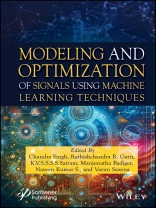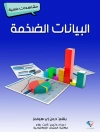Explore the power of machine learning to revolutionize signal processing and optimization with cutting-edge techniques and practical insights in this outstanding new volume from Scrivener Publishing.
Modeling and Optimization of Signals using Machine Learning Techniques is designed for researchers from academia, industries, and R&D organizations worldwide who are passionate about advancing machine learning methods, signal processing theory, data mining, artificial intelligence, and optimization. This book addresses the role of machine learning in transforming vast signal databases from sensor networks, internet services, and communication systems into actionable decision systems. It explores the development of computational solutions and novel models to handle complex real-world signals such as speech, music, biomedical data, and multimedia.
Through comprehensive coverage of cutting-edge techniques, this book equips readers with the tools to automate signal processing and analysis, ultimately enhancing the retrieval of valuable information from extensive data storage systems. By providing both theoretical insights and practical guidance, the book serves as a comprehensive resource for researchers, engineers, and practitioners aiming to harness the power of machine learning in signal processing.
Whether for the veteran engineer, scientist in the lab, student, or faculty, this groundbreaking new volume is a valuable resource for researchers and other industry professionals interested in the intersection of technology and agriculture.
Table of Content
Preface
1. Land Use and Land Cover Mapping of Remotely Sensed Data Using Fuzzy Set Theory-Related Algorithm<
Adithya Kumar and Shivakumar B.R.
1.1 Introduction
1.2 Image Classification
1.3 Unsupervised Classification
1.4 Supervised Classification
1.5 Overview of Fuzzy Sets
1.6 Methodology
1.7 Results and Discussion
1.8 Conclusion
References
2. Role of AI in Mortality Prediction in Intensive Care Unit Patients
Prabhudutta Ray, Sachin Sharma, Raj Rawal and Dharmesh Shah
2.1 Introduction
2.2 Background
2.3 Objectives
2.4 Machine Learning and Mortality Prediction
2.5 Discussions
2.6 Conclusion
2.7 Future Work
2.8 Acknowledgments
2.9 Funding
2.10 Competing Interest
References
3. A Survey on Malware Detection Using Machine Learning
Devika S. P., Pooja M. R. and Arpitha M. S.
3.1 Background
3.2 Introduction
3.3 Literature Survey
3.4 Discussion
3.5 Conclusion
References
4. EEG Data Analysis for IQ Test Using Machine Learning Approaches: A Survey
Bhoomika Patel H. C., Ravikumar V. and Pavan Kumar S. P.
Introduction
4.1 Related Work
4.2 Equations
4.3 Classification
4.4 Data Set
4.5 Information Obtained by EEG Signals
4.6 Discussion
4.7 Conclusion
References
5. Machine Learning Methods in Radio Frequency and Microwave Domain
Shanthi P. and Adish K.
5.1 Introduction
5.2 Background on Machine Learning
5.3 ML in RF Circuit Modeling and Synthesis
5.4 Conclusion
References
6. A Survey: Emotion Detection Using Facial Reorganization Using Convolutional Neural Network (CNN) and Viola–Jones Algorithm
Vaibhav C. Gandhi, Dwij Kishor Siyal, Shivam Pankajkumar Patel and Arya Vipesh Shah
6.1 Introduction
6.2 Review of Literature
6.3 Report on Present Investigation
6.4 Algorithms
6.5 Viola–Jones Algorithm
on 6.6 Diagram
6.7 Results and Discussion
6.8 Limitations and Future Scope
6.9 Summary and Conclusion
References
7. Power Quality Events Classification Using Digital Signal Processing and Machine Learning Techniques
E. Fantin Irudaya Raj and M. Balaji
7.1 Introduction
7.2 Methodology for the Identification of PQ Events
7.3 Power Quality Problems Arising in the Modern Power System
7.4 Digital Signal Processing-Based Feature Extraction of PQ Events
7.5 Feature Selection and Optimization
7.6 Machine Learning-Based Classification of PQ Disturbances
7.7 Summary and Conclusion
References
8. Hybridization of Artificial Neural Network with Spotted Hyena Optimization (SHO) Algorithm for Heart Disease Detection
Shwetha N., Gangadhar N., Mahesh B. Neelagar, Sangeetha N. and Virupaxi Dalal
8.1 Introduction
8.2 Literature Survey
8.3 Proposed Methodology
8.4 Artificial Neural Network
8.5 Software Implementation Requirements
8.6 Conclusion
References
9. The Role of Artificial Intelligence, Machine Learning, and Deep Learning to Combat the Socio-Economic Impact of the Global COVID-19 Pandemic
Biswa Ranjan Senapati, Sipra Swain and Pabitra Mohan Khilar
9.1 Introduction
9.2 Discussions on the Coronavirus
9.3 Bad Impacts of the Coronavirus
9.4 Benefits Due to the Impact of COVID-19
9.5 Role of Technology to Combat the Global Pandemic COVID-19
9.6 The Role of Artificial Intelligence, Machine Learning, and Deep Learning in COVID-19
9.7 Related Studies
9.8 Conclusion
References
10. A Review on Smart Bin Management Systems
Bhoomika Patel H. C., Soundarya B. C. and Pooja M. R.
10.1 Introduction
10.2 Related Work
10.3 Challenges, Solution, and Issues
10.4 Advantages
Conclusion
References
11. Unlocking Machine Learning: 10 Innovative Avenues to Grasp Complex Concepts
K. Vidhyalakshmi and S. Thanga Ramya
11.1 Regression
11.2 Classification
11.3 Clustering
11.4 Clustering (k-means)
11.5 Reduction of Dimensionality
11.6 The Ensemble Method
11.7 Transfer of Learning
11.8 Learning Through Reinforcement
11.9 Processing of Natural Languages
11.10 Word Embeddings
11.11 Conclusion
References
12. Recognition Attendance System Ensuring COVID-19 Security
Praveen Kumar M., Ramya Poojary, Saksha S. Bhandary and Sushmitha M. Kulal
12.1 Introduction
12.2 Literature Survey
12.3 Software Requirements
12.4 Hardware Requirements
12.5 Methodology
12.6 Building the Database
12.7 Pi Camera for Extracting Face Features
12.8 Real-Time Testing on Raspberry Pi
12.9 Contactless Body Temperature Monitoring
12.10 Raspberry-Pi Setting Up an SMTP Email
12.11 Uploading to the Database
12.12 Updating the Website
12.13 Report Generation
12.14 Result
12.15 Discussion
12.16 Conclusion
References
13. Real-Time Industrial Noise Cancellation for the Extraction of Human Voice
Vinayprasad M. S., Chandrashekar Murthy B. N. and Yashwanth S. D.
13.1 Introduction
13.2 Literature Survey
13.3 Methodology
13.4 Experimental Results
13.5 Conclusion
References
14. Machine Learning-Based Water Monitoring System Using Io T
T. Kesavan, E. Kaliappan, K. Nagendran and M. Murugesan
14.1 Introduction
14.2 Smart Water Monitoring System
14.3 Sensors and Hardware
14.4 Power BI Reports
14.5 Conclusion
References
15. Design and Modelling of an Automated Driving Inspector Powered by Arduino and Raspberry Pi
Raghunandan K. R., Dilip Kumar K., Krishnaraj Rao N.S. Krishnaprasad Rao and Bhavya K.
15.1 Introduction
15.2 Literature Survey
15.3 Results
15.4 Conclusion
References
16. Kalman Filter-Based Seizure Prediction Using Concatenated Serial-Parallel Block Technique
Purnima P. S. and Suresh M.
16.1 Introduction
16.2 Prior Work
16.3 Proposed Method
16.4 Serial-Parallel Block Concatenation Approach
16.5 Algorithm
16.6 Kalman Filter
16.7 Results and Discussion
16.8 Conclusion
References
17. Current Advancements in Steganography: A Review
Mallika Garg, Jagpal Singh Ubhi and Ashwani Kumar Aggarwal
17.1 Introduction
17.2 Evaluation Parameters
17.3 Types of Steganography
17.4 Traditional Steganographic Techniques
17.5 CNN-Based Steganographic Techniques
17.6 GAN-Based Steganographic Techniques
17.7 Steganalysis
17.8 Applications
17.9 Dataset Used for Steganography
17.10 Conclusion
References
18. Human Emotion Recognizing Intelligence System Using Machine Learning
Bhakthi P. Alva, Krishma Bopanna N., Prajwal S., Varun A. Naik and Lahari Vaidya
18.1 Introduction
18.2 Literature Review
18.3 Problem Statement
18.4 Methodology
18.5 Results
18.6 Applications
18.7 Conclusion
18.8 Future Work
References
19. Computing in Cognitive Science Using Ensemble Learning
Om Prakash Singh
19.1 Introduction
19.2 Recognition of Human Activities
19.3 Methodology
19.4 Applying the Boosting-Based Ensemble Learning
19.5 Human Activity Features Computability
19.6 Conclusion
References
About the Editors
Index
About the author
Chandra Singh is an assistant professor in the Department of Electronics and Communication Engineering at Sahyadri College of Engineering and Management, Mangalore, India, and is pursuing a Ph D from VTU Belagavi, India. He has four patents, he has published over 25 papers in scientific journals, and he is the editor of seven books.
Rathishchandra R. Gatti, Ph D, is an associate professor at Jawaharlal Nehru University, Delhi, India. With over 20 years of industrial, research, and teaching experience under his belt, he also has four patents, has published over 40 papers in scientific journals, and is the editor of seven research books and one journal.
K.V.S.S.S.S.SAIRAM, Ph D, is a professor and Head of the Electronics and Communication Engineering Department at the NMAM Institute of Technology, Nitte, India. He has 25 years of experience in teaching and research and has published over 50 papers in international journals and conferences. He is also a reviewer for several journals.
Manjunatha Badiger, Ph D, is an assistant professor at Sahyadri College of Engineering and Management, Adyar, Mangalore, Karnataka, India. He has over 12 years of experience in academics, research, and administration. He earned his Ph D in machine learning in 2024 at Visvesvaraya Technological University.
Naveen Kumar S., MTech, is an assistant professor at the Sahyadri College of Engineering and Management. Previously he was an assistant professor at JSS Academy of Technical Education, Noida, India. He obtained his MTech in automotive electronics from Sri Jayachamarajendra College of Engineering, Mysore, India.
Varun Saxena, Ph D, received his Ph D in electromagnetic ion traps from IIT Delhi, New Delhi, in 2018. He is currently an assistant professor at the School of Engineering, Jawaharlal Nehru University, New Delhi.












